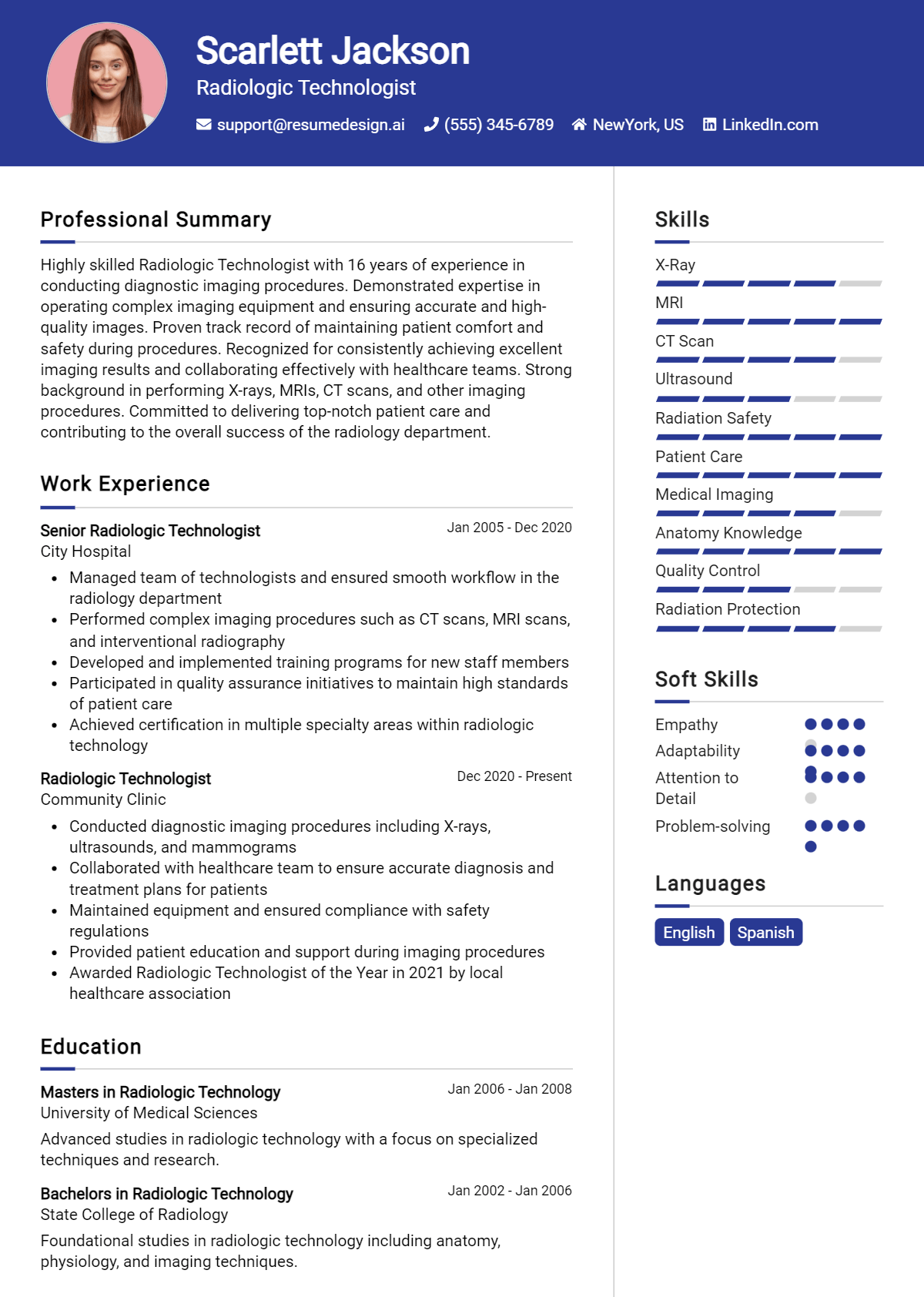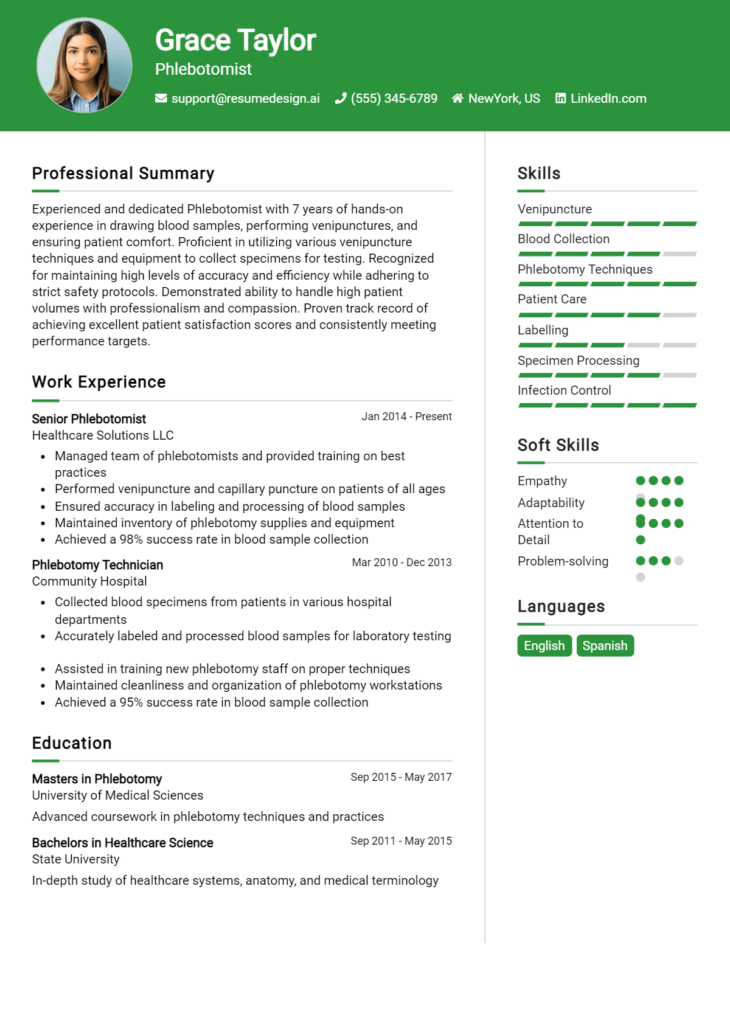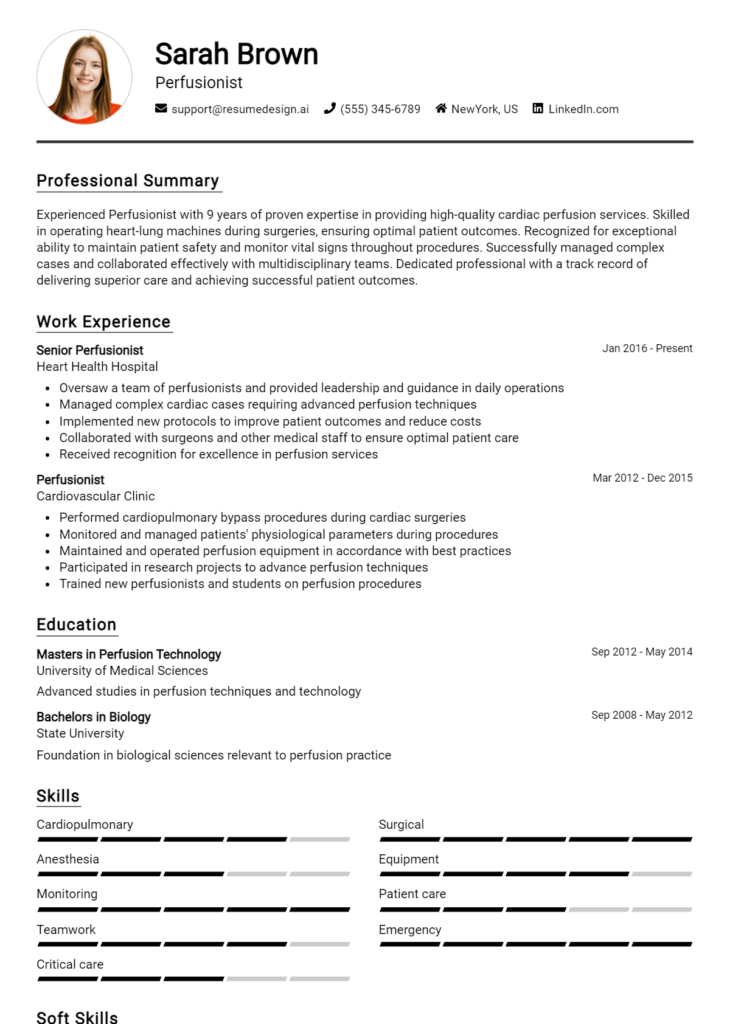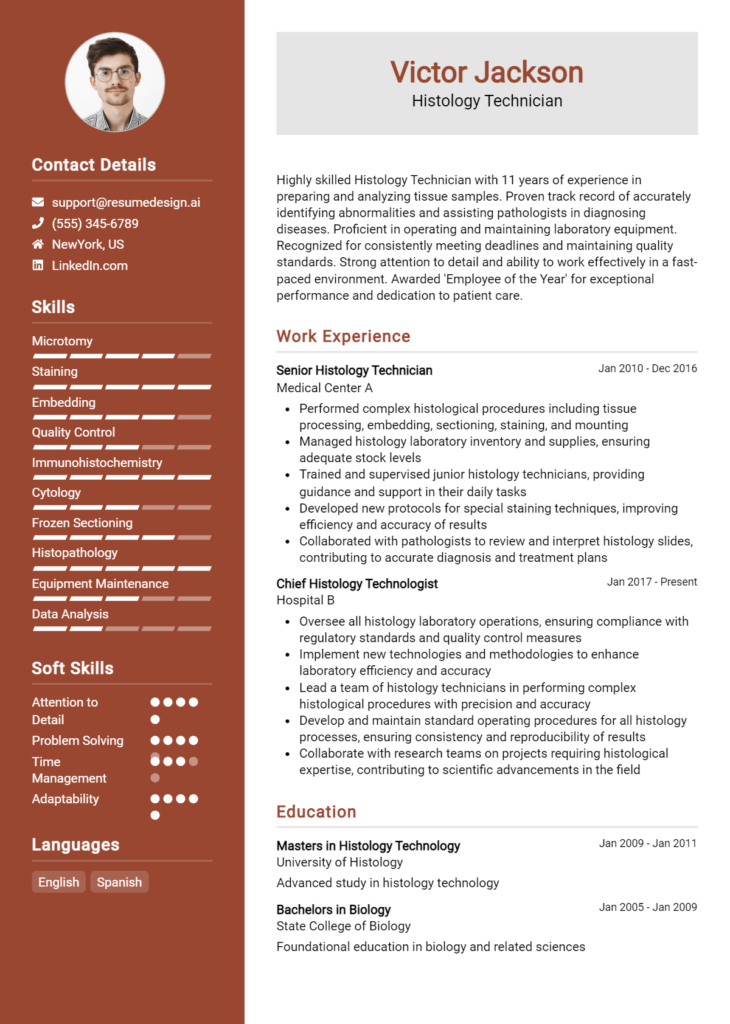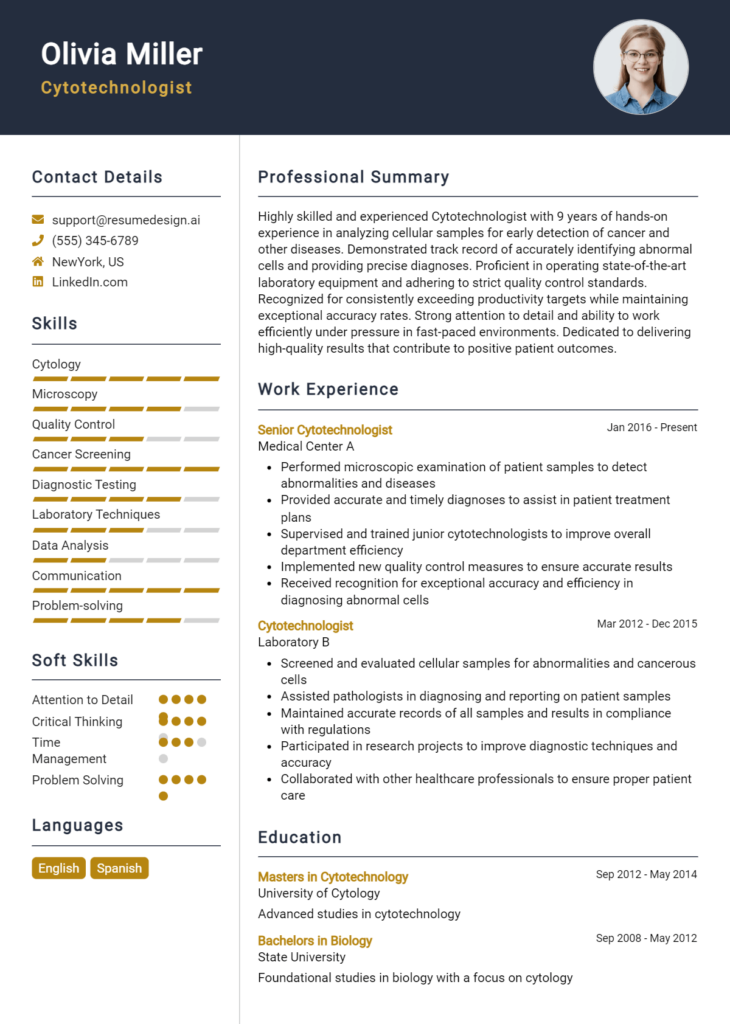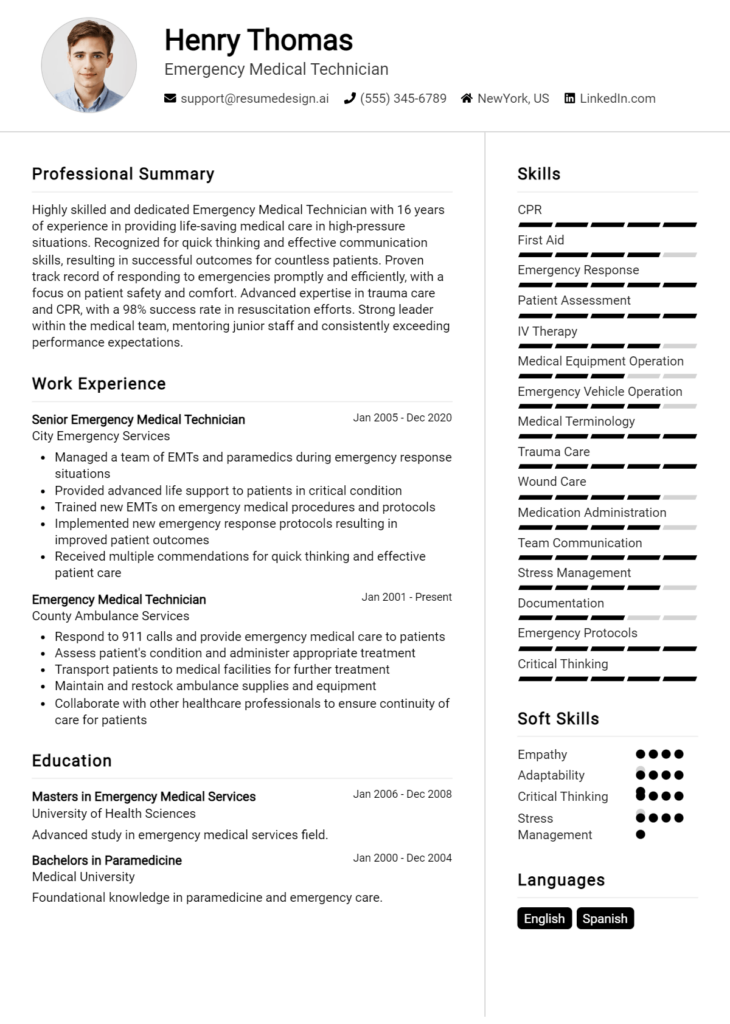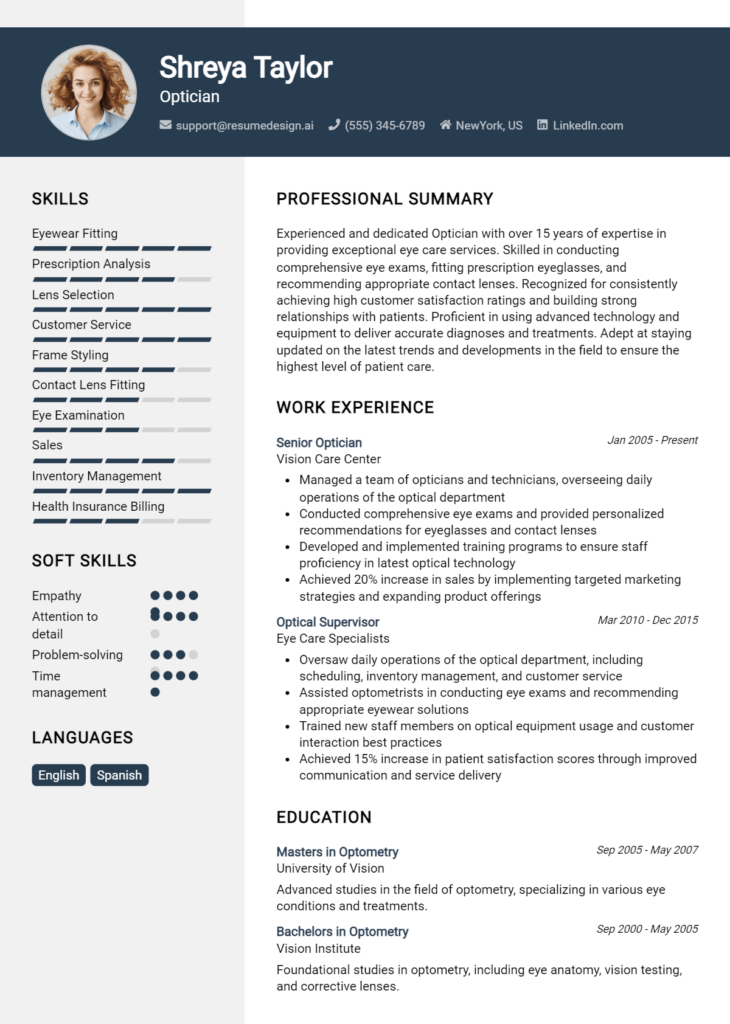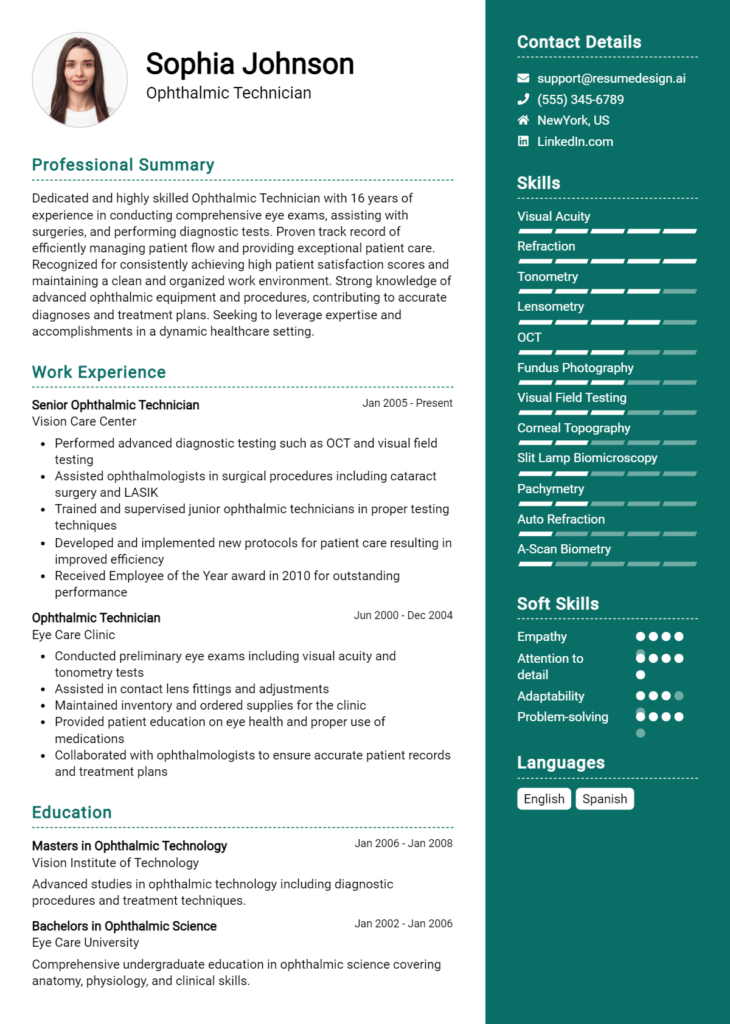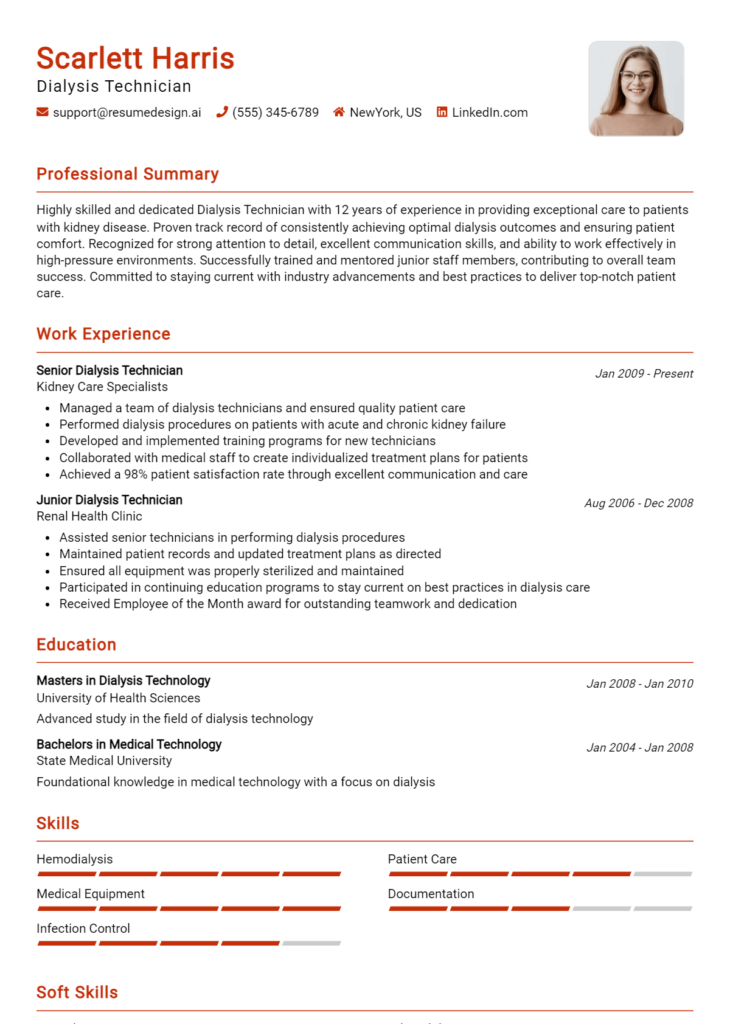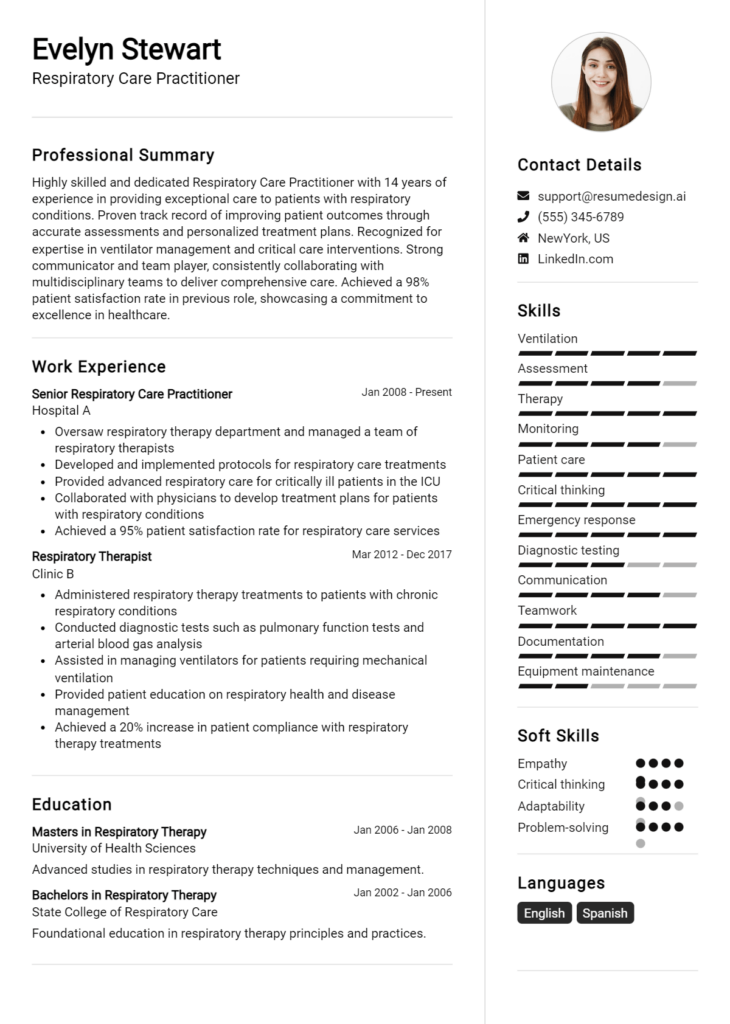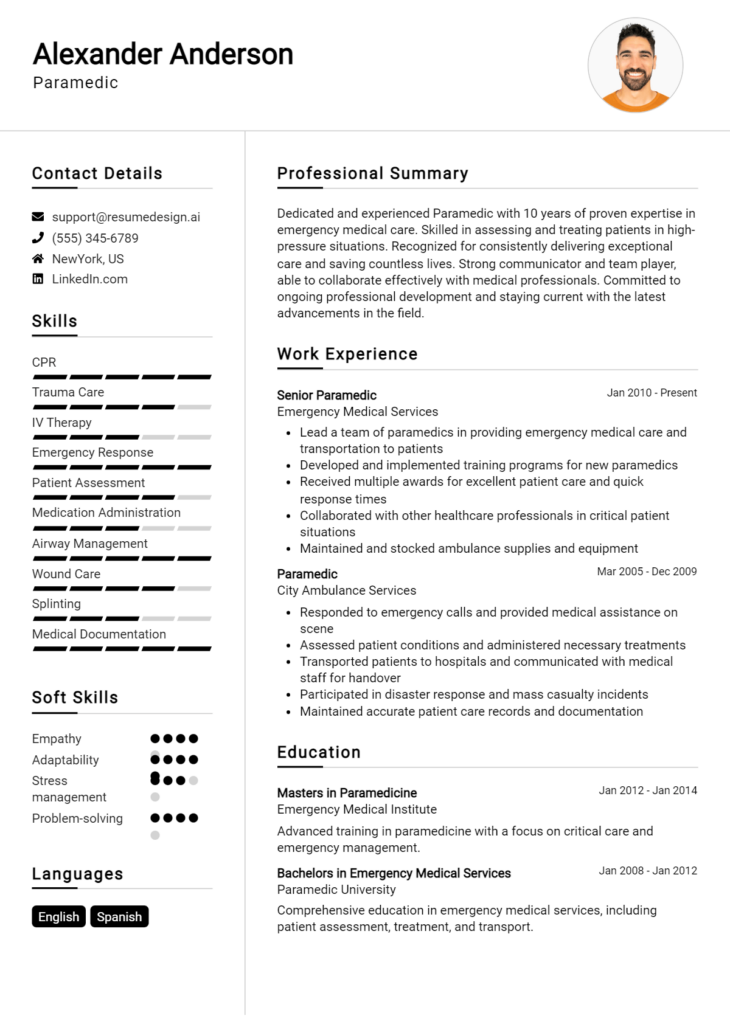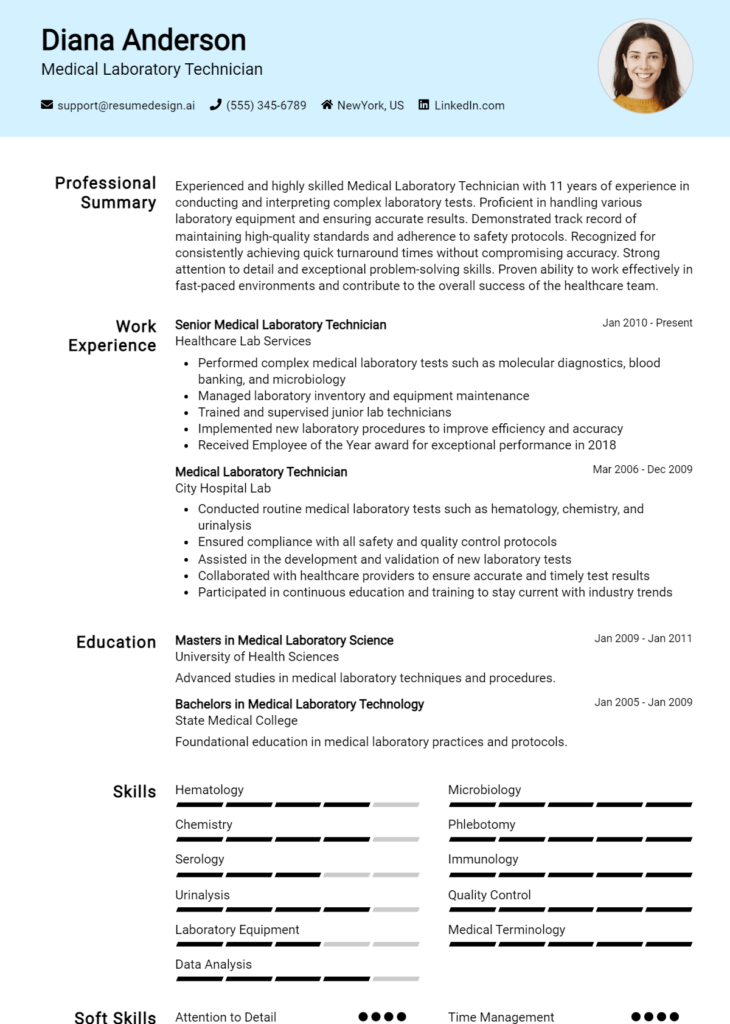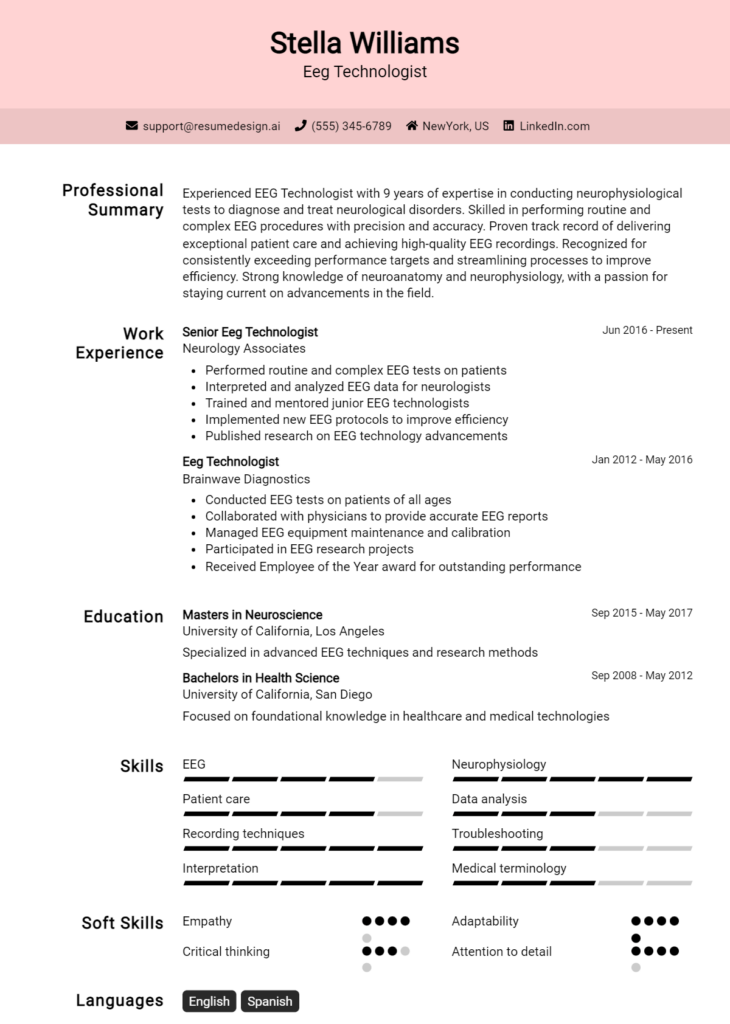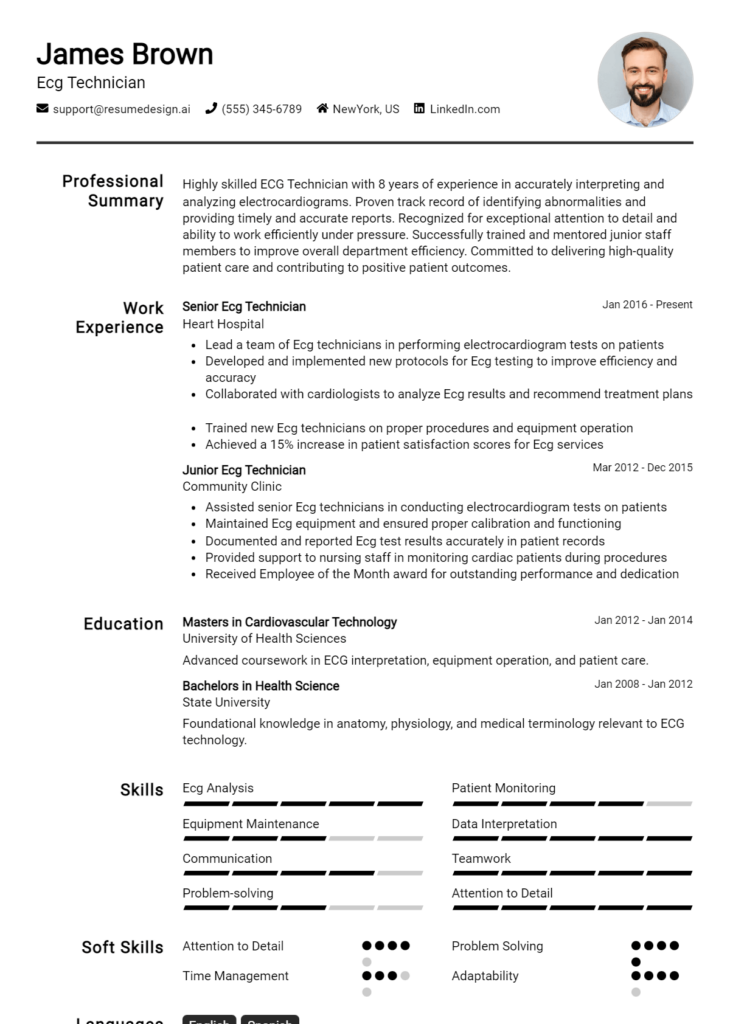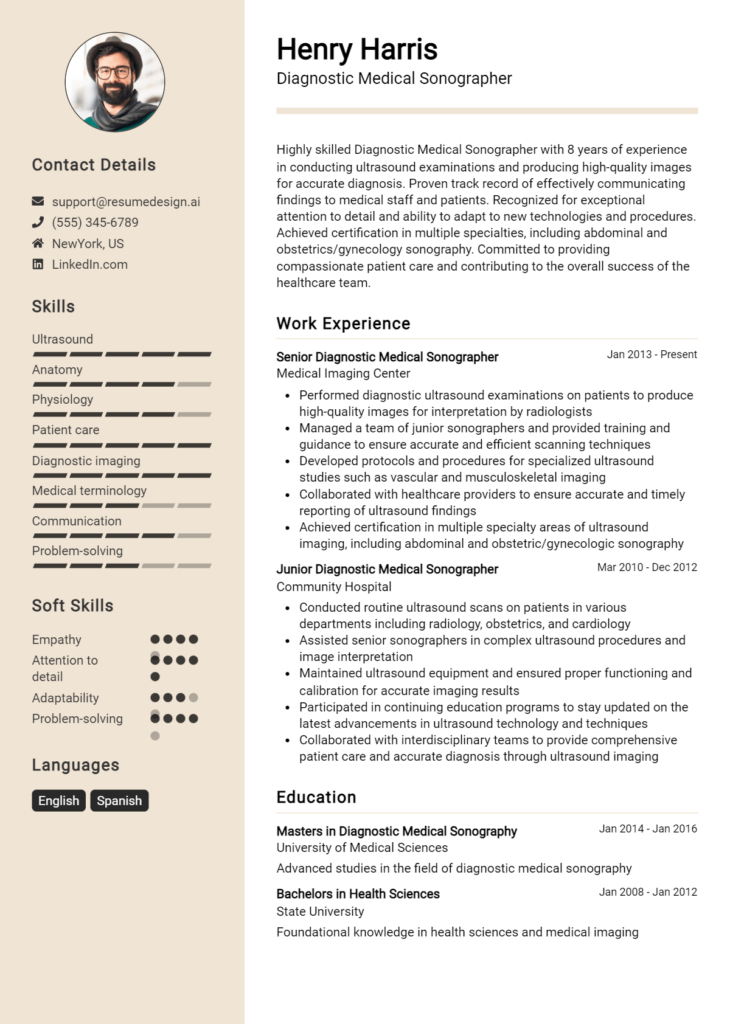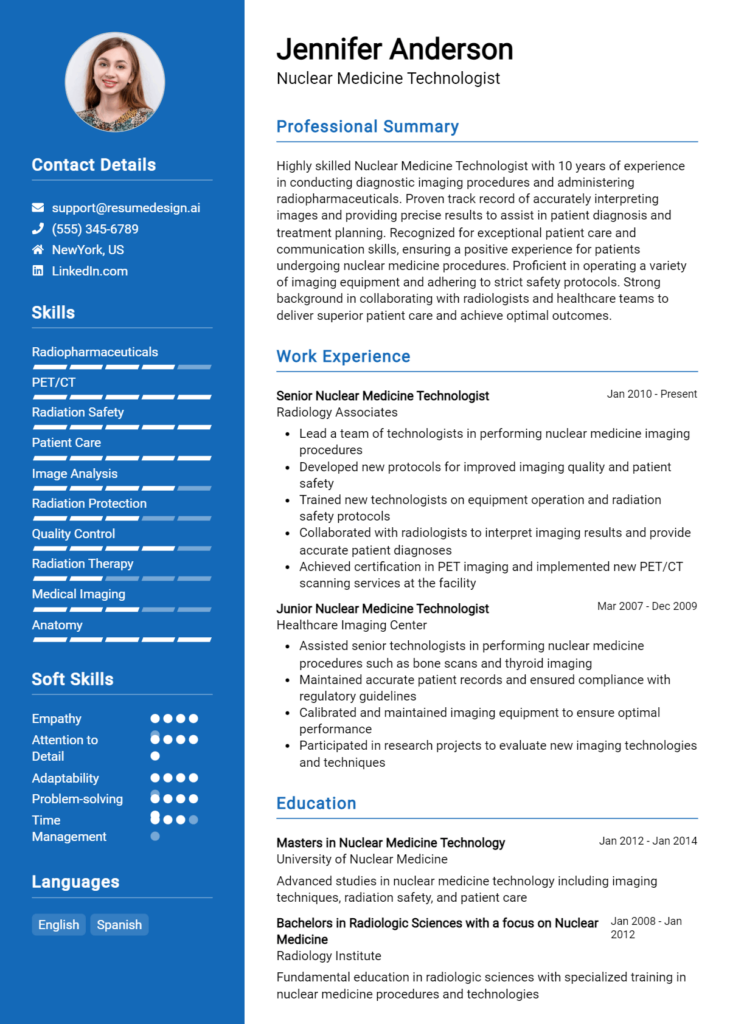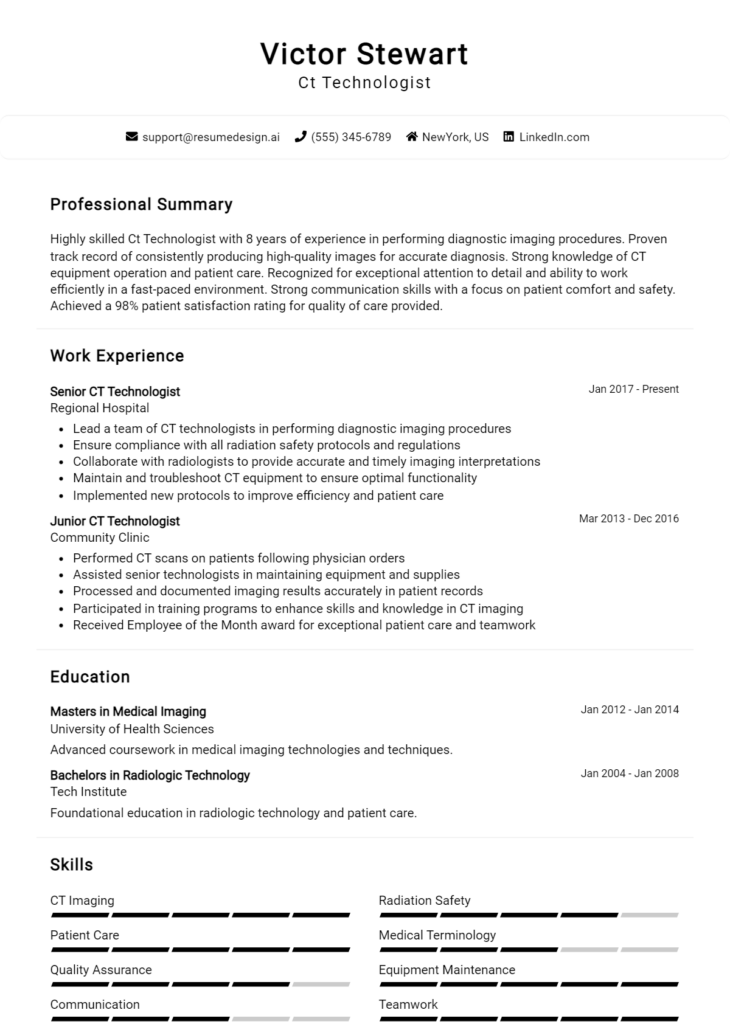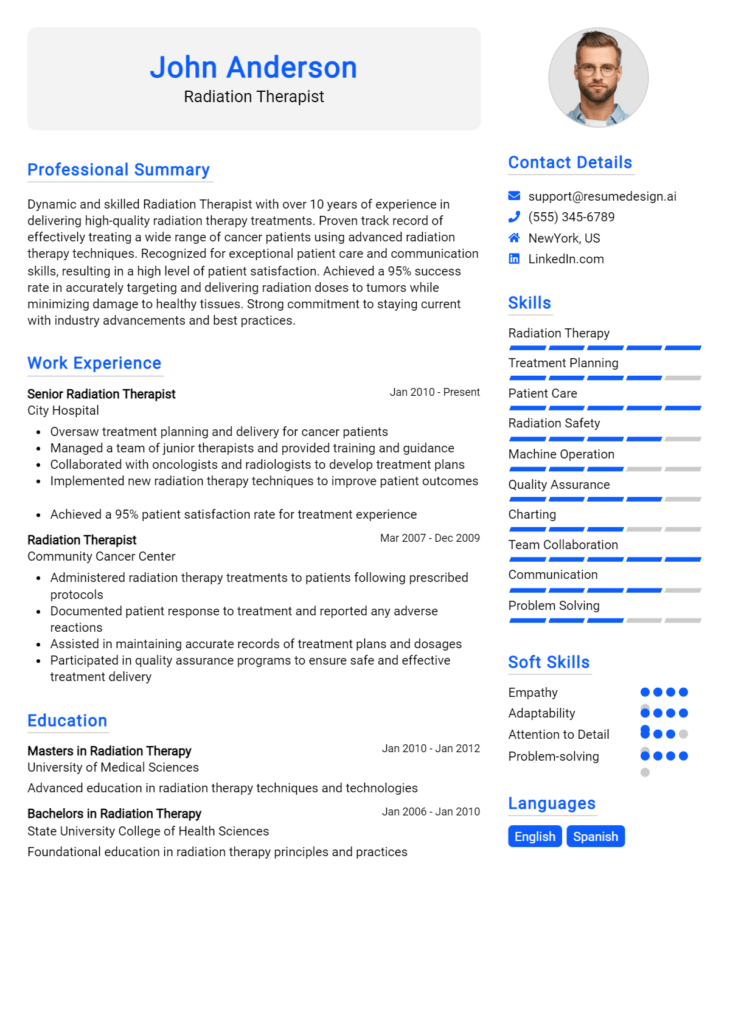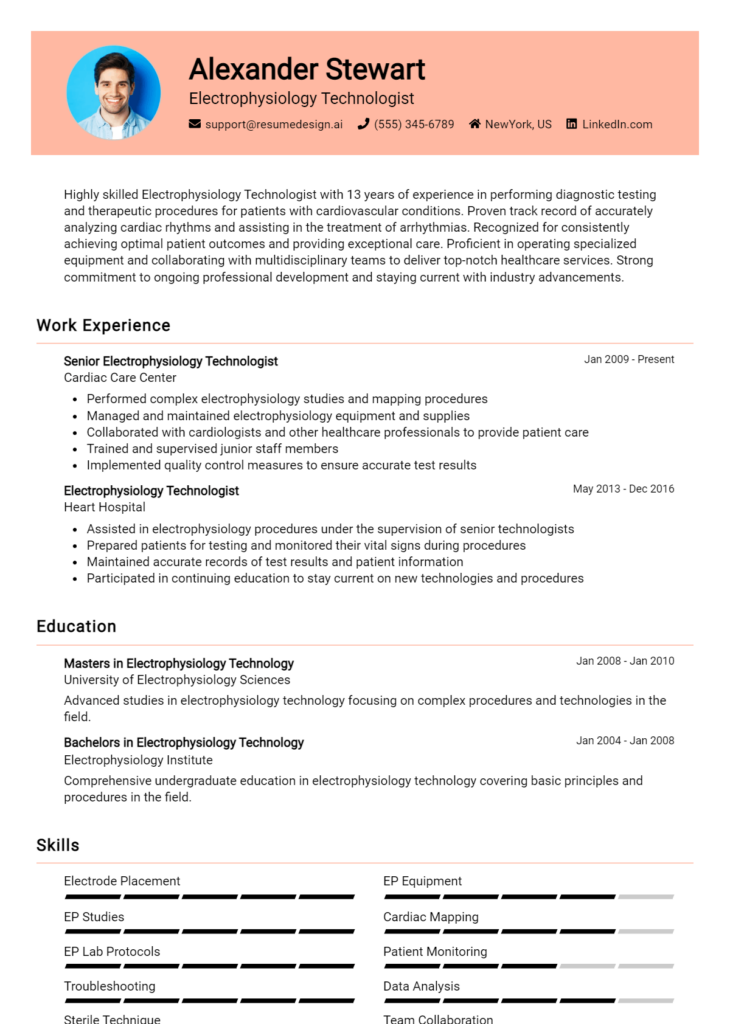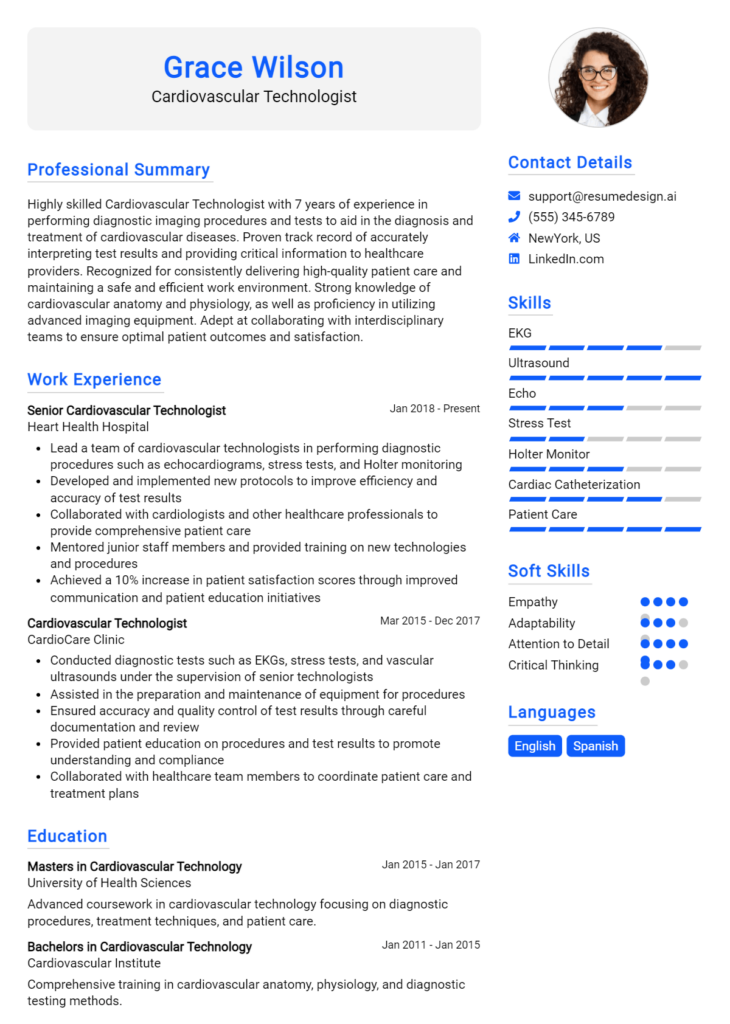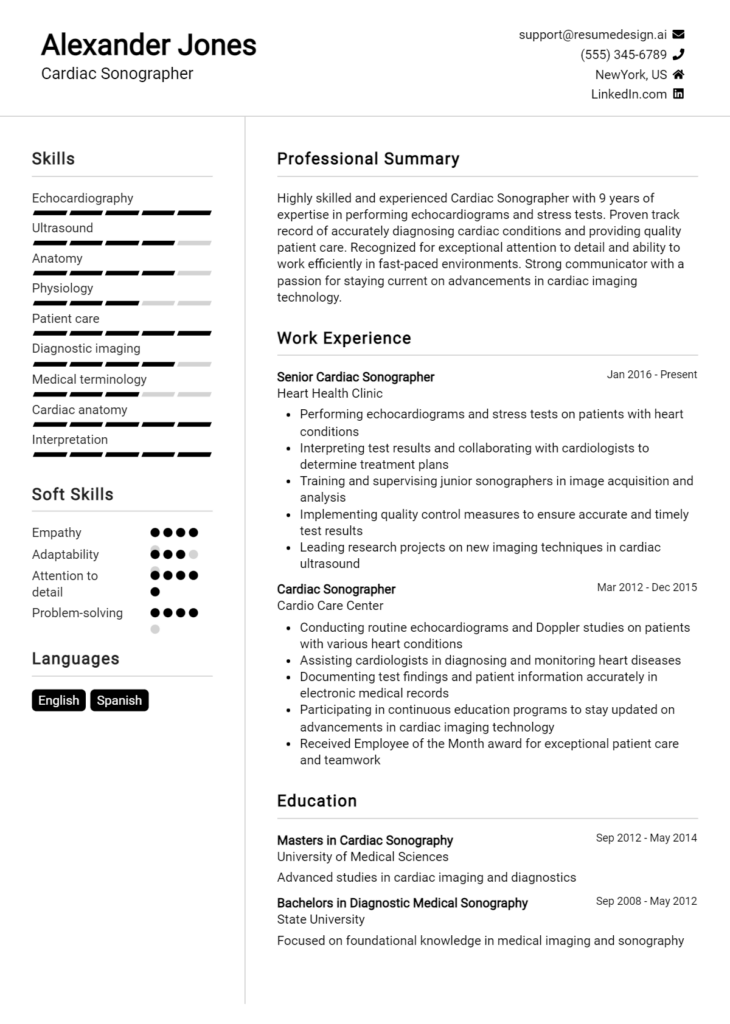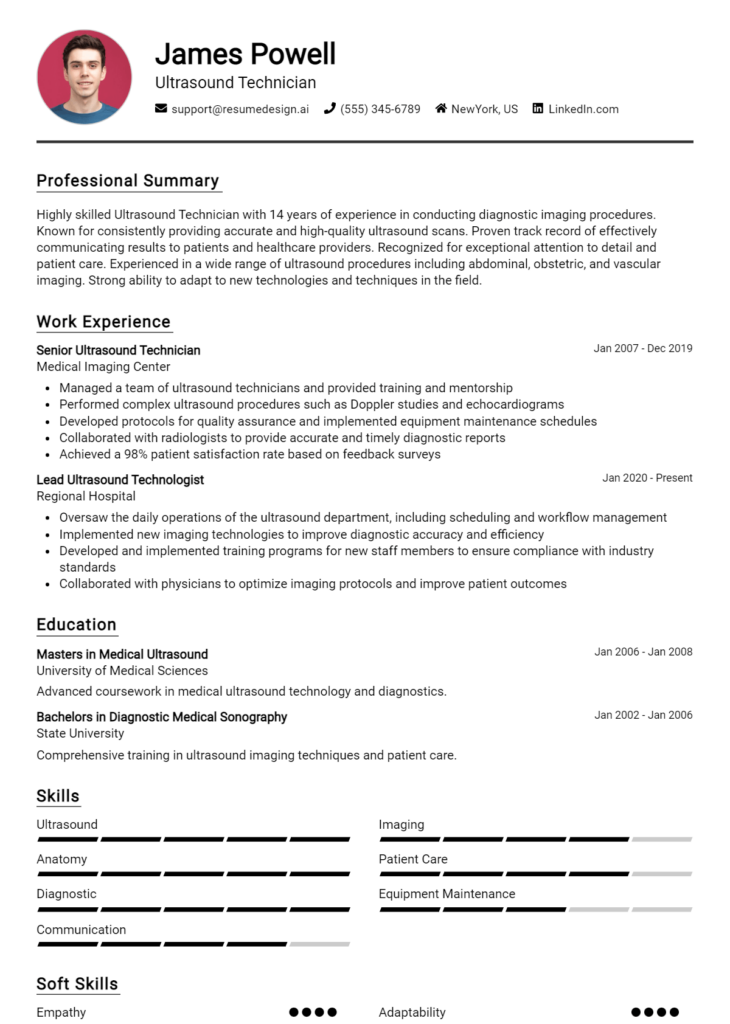Radiologic Technologist Core Responsibilities
A Radiologic Technologist plays a crucial role in the healthcare system, bridging the gap between various departments such as radiology, nursing, and patient care. Their core responsibilities include operating imaging equipment, ensuring patient safety, and maintaining accurate records. Necessary skills encompass technical proficiency with imaging technology, operational efficiency, and strong problem-solving abilities to address challenges in patient care. These competencies contribute significantly to the organization’s goals by enhancing diagnostic accuracy. A well-structured resume can effectively showcase these qualifications, highlighting the radiologic technologist's vital contributions to the team.
Common Responsibilities Listed on Radiologic Technologist Resume
- Perform diagnostic imaging procedures, including X-rays and MRIs.
- Prepare and position patients for imaging exams.
- Ensure compliance with safety protocols and radiation protection guidelines.
- Maintain and troubleshoot imaging equipment.
- Collaborate with physicians to determine imaging requirements.
- Document patient history and imaging results accurately.
- Provide patient education regarding imaging procedures.
- Assist in maintaining inventory and ordering supplies.
- Participate in quality assurance and performance improvement initiatives.
- Stay updated on advancements in radiologic technology.
High-Level Resume Tips for Radiologic Technologist Professionals
In the competitive field of radiologic technology, a well-crafted resume is not just a formality; it is often the first impression a candidate makes on a potential employer. Your resume serves as a vital tool to showcase your skills, achievements, and relevant experience in a concise and compelling manner. It should reflect not only your technical competencies but also your commitment to patient care and safety. This guide will provide practical and actionable resume tips specifically tailored for Radiologic Technologist professionals, ensuring that your application stands out in a crowded job market.
Top Resume Tips for Radiologic Technologist Professionals
- Tailor your resume for each job application by aligning your skills and experiences with the specific requirements outlined in the job description.
- Highlight your relevant certifications and licenses, such as ARRT certification, to demonstrate your qualifications and adherence to industry standards.
- Showcase your clinical experience by detailing specific roles and responsibilities in previous positions, focusing on your direct contributions to patient care.
- Quantify your achievements wherever possible, using metrics to illustrate the impact of your work, such as improved patient satisfaction scores or reduced wait times.
- Include a skills section that emphasizes both technical skills (e.g., proficiency in imaging equipment) and soft skills (e.g., communication and teamwork).
- Utilize action verbs in your job descriptions to convey a sense of initiative and accomplishment, such as "performed," "collaborated," and "managed."
- Incorporate any specialized training or continuing education courses relevant to radiologic technology to demonstrate your commitment to professional development.
- Keep your resume concise and focused, ideally one page, to ensure that hiring managers can quickly identify your qualifications.
- Proofread your resume carefully to eliminate any errors or inconsistencies, as attention to detail is crucial in the medical field.
By implementing these tips, you can significantly enhance your chances of landing a job in the Radiologic Technologist field. A strong resume not only showcases your qualifications but also communicates your professionalism and dedication to the role, making you a more appealing candidate to potential employers.
Why Resume Headlines & Titles are Important for Radiologic Technologist
The role of a Radiologic Technologist is essential in the healthcare field, as these professionals utilize advanced imaging technologies to assist in diagnosing and treating patients. When it comes to crafting a resume, the importance of a strong headline or title cannot be overstated. A compelling headline acts as the first impression, immediately grabbing the attention of hiring managers and summarizing a candidate's key qualifications in one impactful phrase. An effective resume headline should be concise, relevant, and directly related to the job being applied for, setting the tone for the rest of the application.
Best Practices for Crafting Resume Headlines for Radiologic Technologist
- Keep it concise: Aim for a headline that is brief yet informative.
- Be role-specific: Clearly define your role as a Radiologic Technologist in the headline.
- Highlight key skills: Include specific skills or certifications relevant to the job.
- Use action words: Start with strong action verbs to convey confidence and competence.
- Tailor to the job: Customize the headline for each application to match the job description.
- Include relevant experience: Mention years of experience or notable achievements when possible.
- Avoid clichés: Steer clear of overused phrases that dilute your message.
- Make it impactful: Aim for a headline that resonates with hiring managers and sets you apart.
Example Resume Headlines for Radiologic Technologist
Strong Resume Headlines
Dedicated Radiologic Technologist with 5+ Years of Experience in Advanced Imaging Techniques
Certified Radiologic Technologist Specializing in MRI and CT Scans with a Proven Record of Patient Care
Compassionate Radiologic Technologist Committed to High-Quality Imaging and Patient Safety
Experienced Radiologic Technologist with Expertise in Digital Imaging and Radiation Safety Compliance
Weak Resume Headlines
Radiologic Technologist Looking for Work
Healthcare Professional with Imaging Experience
Technologist in Radiology
The strong headlines are effective because they clearly communicate the candidate’s specific qualifications, skills, and experience relevant to the Radiologic Technologist role. They utilize impactful language that conveys professionalism and expertise, making a strong first impression on hiring managers. In contrast, the weak headlines fail to impress due to their vagueness and lack of specificity, which can leave hiring managers uncertain about the candidate's relevant capabilities and overall fit for the position. A well-crafted resume headline can be the difference between landing an interview and being overlooked.
Writing an Exceptional Radiologic Technologist Resume Summary
A well-crafted resume summary is crucial for Radiologic Technologists, as it serves as the first impression that hiring managers will have of a candidate. A strong summary quickly captures attention by succinctly showcasing key skills, relevant experience, and noteworthy accomplishments in the field of radiology. It should be concise yet impactful, effectively highlighting what makes the candidate a strong fit for the position while being tailored to the specific job they are applying for. This strategic approach helps candidates stand out in a competitive job market and sets the stage for the rest of their resume.
Best Practices for Writing a Radiologic Technologist Resume Summary
- Quantify achievements: Use numbers and metrics to demonstrate your impact, such as the number of patients treated or the accuracy of your imaging results.
- Focus on relevant skills: Highlight specific technical skills and certifications that are crucial for the role, such as proficiency in MRI, CT scans, or X-ray technology.
- Tailor the summary: Customize your resume summary to align with the job description, emphasizing skills and experiences that match the employer's needs.
- Keep it concise: Aim for 2-4 sentences that deliver a powerful message without overwhelming the reader.
- Showcase key accomplishments: Mention significant milestones in your career, such as awards, recognitions, or successful projects.
- Use action verbs: Start sentences with strong action verbs to convey confidence and initiative.
- Maintain a professional tone: Use industry-specific language to convey your expertise while remaining clear and accessible.
- Reflect your passion: Include a statement that conveys your dedication to patient care and the radiology profession.
Example Radiologic Technologist Resume Summaries
Strong Resume Summaries
Dedicated Radiologic Technologist with over 5 years of experience in performing diagnostic imaging procedures. Successfully reduced patient wait times by 20% through streamlined scheduling processes, ensuring timely and effective patient care.
Detail-oriented Radiologic Technologist skilled in MRI and CT imaging, with a proven track record of maintaining 98% accuracy in image interpretation. Recipient of the 'Excellence in Patient Care' award for outstanding service in a fast-paced hospital environment.
Compassionate Radiologic Technologist with expertise in X-ray and fluoroscopy, having conducted over 3,000 imaging procedures annually. Known for exceptional patient rapport and a commitment to minimizing patient discomfort during examinations.
Weak Resume Summaries
Radiologic Technologist looking for a job. I have experience in imaging and enjoy working with patients.
An experienced healthcare professional with skills in radiology. I am seeking new opportunities in the medical field.
The strong resume summaries are considered effective because they include specific achievements, relevant skills, and quantifiable results that demonstrate the candidate's impact in their previous roles. In contrast, the weak resume summaries lack detail and specificity, making them generic and less compelling. They fail to convey the candidate's unique qualifications or contributions to the field, which can lead to a lack of interest from hiring managers.
Work Experience Section for Radiologic Technologist Resume
The work experience section of a Radiologic Technologist resume is crucial as it provides potential employers with insight into a candidate's technical skills, their ability to manage teams, and their commitment to delivering high-quality diagnostic imaging services. This section acts as a showcase for relevant experience, illustrating how candidates have applied their knowledge in real-world settings. Quantifying achievements—such as the number of procedures performed or improvements in patient care metrics—can significantly enhance a resume, while aligning experiences with industry standards demonstrates a candidate's awareness of best practices in the field. A well-crafted work experience section can set a candidate apart in a competitive job market.
Best Practices for Radiologic Technologist Work Experience
- Highlight specific technical skills relevant to radiology, such as proficiency in MRI, CT, and X-ray technologies.
- Quantify your achievements with metrics, such as the number of patients serviced or reductions in wait times.
- Showcase leadership abilities by detailing experiences in team management or mentoring junior staff.
- Include certifications and training that align with industry standards, demonstrating ongoing professional development.
- Emphasize collaboration with healthcare professionals to enhance patient care and outcomes.
- Detail your role in implementing new technologies or processes that improved efficiency or accuracy.
- Use action verbs to convey your contributions effectively and create a dynamic narrative.
- Tailor your experience to the job description, ensuring relevance to the prospective employer's needs.
Example Work Experiences for Radiologic Technologist
Strong Experiences
- Performed over 1,000 diagnostic imaging procedures annually, achieving a 98% patient satisfaction rating.
- Led a team of 5 radiologic technologists in implementing a new digital imaging system, resulting in a 30% increase in workflow efficiency.
- Collaborated with physicians to develop customized imaging protocols, reducing unnecessary repeat scans by 25%.
- Trained and mentored 10+ junior staff members, enhancing team performance and ensuring adherence to safety standards.
Weak Experiences
- Worked as a radiologic technologist at a hospital.
- Assisted in patient imaging as part of a team.
- Performed imaging procedures when needed.
- Helped with various tasks in the radiology department.
The examples classified as strong experiences stand out due to their specificity and quantifiable results, which demonstrate the candidate's impact on patient care and departmental efficiency. In contrast, the weak experiences lack detail and measurable outcomes, making them less compelling to potential employers. Strong experiences convey a clear narrative of leadership, technical expertise, and collaborative efforts, while weak experiences fail to showcase the candidate's true abilities and contributions in the field of radiology.
Education and Certifications Section for Radiologic Technologist Resume
The education and certifications section of a Radiologic Technologist resume is crucial as it showcases the candidate's academic background and professional qualifications. This section serves to highlight not only the foundational knowledge gained through formal education but also any industry-relevant certifications that demonstrate proficiency in specialized areas of radiologic technology. By including relevant coursework and specialized training, candidates can illustrate their commitment to continuous learning and professional development, significantly enhancing their credibility and alignment with the specific demands of the job role.
Best Practices for Radiologic Technologist Education and Certifications
- List degrees in reverse chronological order, starting with the most recent.
- Include specific certifications relevant to the position, such as ARRT certification or state licensure.
- Highlight any specialized training in advanced imaging techniques or modalities.
- Provide details on relevant coursework that aligns with the job description.
- Indicate the dates of graduation or certification to show currency in the field.
- Consider including professional development courses to demonstrate ongoing education.
- Use clear formatting to ensure easy readability and quick reference for hiring managers.
- Tailor this section to match the requirements and preferences outlined in the job posting.
Example Education and Certifications for Radiologic Technologist
Strong Examples
- Bachelor of Science in Radiologic Technology, University of Health Sciences, May 2022
- ARRT Certified Radiologic Technologist, Certified in 2022
- Specialized Training in MRI Technology, Advanced Imaging Institute, 2023
- Relevant Coursework: Patient Care in Radiologic Technology, Advanced Imaging Modalities
Weak Examples
- Associate Degree in General Studies, Community College, 2010
- Basic CPR Certification, Expired 2021
- Certification in X-Ray Basics, Online Course, 2015
- High School Diploma, Graduated 2005
The examples listed above are considered strong because they reflect recent and relevant educational achievements and certifications that are directly applicable to the role of a Radiologic Technologist. They indicate a solid academic foundation and ongoing commitment to professional development. Conversely, the weak examples highlight outdated or irrelevant qualifications that do not align with the current requirements of the field, such as expired certifications and unrelated degrees, which can detract from the candidate's suitability for the position.
Top Skills & Keywords for Radiologic Technologist Resume
In the competitive field of radiologic technology, showcasing a well-rounded skill set on your resume is essential for standing out to potential employers. As a Radiologic Technologist, you are not only responsible for performing diagnostic imaging procedures but also for ensuring patient safety, comfort, and communication. The right mix of hard and soft skills can demonstrate your technical proficiency and your ability to work empathetically in a healthcare environment. Highlighting these skills effectively can make your resume more compelling and increase your chances of landing an interview. For more insights on essential skills and how to present your work experience, consider the following lists.
Top Hard & Soft Skills for Radiologic Technologist
Soft Skills
- Excellent communication skills
- Empathy and compassion
- Attention to detail
- Strong analytical thinking
- Problem-solving abilities
- Teamwork and collaboration
- Adaptability and flexibility
- Time management
- Patient-focused care
- Stress management
Hard Skills
- Proficiency in imaging technologies (e.g., MRI, CT, X-ray)
- Knowledge of radiation safety protocols
- Familiarity with medical terminology
- Ability to operate imaging equipment
- Proficient in digital imaging and PACS
- Understanding of anatomy and physiology
- Quality assurance processes
- Data entry and record keeping
- Compliance with healthcare regulations
- Basic life support (BLS) certification
By incorporating these key skills into your resume, you can effectively demonstrate your readiness for the role of a Radiologic Technologist and enhance your appeal to employers in the healthcare sector.
Stand Out with a Winning Radiologic Technologist Cover Letter
Dear Hiring Manager,
I am writing to express my interest in the Radiologic Technologist position at [Company Name], as advertised on [Job Board/Company Website]. With a Bachelor’s degree in Radiologic Technology and over [X years] of hands-on experience in various clinical settings, I am confident in my ability to contribute effectively to your team. My extensive knowledge of radiographic techniques, patient care, and safety protocols has equipped me to provide high-quality imaging services while ensuring patient comfort and safety.
During my previous role at [Previous Employer], I successfully performed a wide range of imaging procedures, including X-rays, CT scans, and MRIs. I take pride in my ability to communicate effectively with patients, explaining procedures and alleviating any concerns they may have. My commitment to adhering to safety standards has resulted in a [specific achievement, such as “zero incidents of repeat imaging” or “recognition for maintaining an exemplary safety record”]. I am also proficient in operating advanced imaging equipment and utilizing electronic health record systems, which enhances workflow efficiency and accuracy in patient data management.
I am particularly drawn to [Company Name] because of its commitment to excellence in patient care and its reputation for innovation in medical imaging technology. I am eager to bring my skills in radiologic imaging and patient interaction to your esteemed facility. I am excited about the opportunity to collaborate with a team of dedicated professionals who share my passion for providing exceptional healthcare services.
Thank you for considering my application. I look forward to the opportunity to discuss how my background, skills, and enthusiasms align with the goals of [Company Name]. I am available at your earliest convenience for an interview and can be reached at [Your Phone Number] or [Your Email Address].
Sincerely,
[Your Name]
[Your LinkedIn Profile or Professional Website, if applicable]
Common Mistakes to Avoid in a Radiologic Technologist Resume
When crafting a resume for a Radiologic Technologist position, it’s essential to present your skills and experience effectively. However, many applicants make common mistakes that can hinder their chances of landing an interview. Avoiding these pitfalls can help ensure that your resume stands out to potential employers and showcases your qualifications. Here are some common mistakes to watch out for:
Not Tailoring the Resume to the Job Description: Failing to customize your resume for each specific job can make it seem generic. Highlight relevant skills and experiences that align with the requirements of the position you're applying for.
Using Unprofessional Formatting: A cluttered or overly complicated layout can distract from your qualifications. Stick to a clean, professional format that is easy to read, with clear headings and consistent font styles.
Including Irrelevant Information: Listing experiences or skills that do not relate to the role of a Radiologic Technologist can dilute the impact of your resume. Focus on relevant clinical experience, certifications, and technical skills.
Neglecting to Highlight Certifications: As a Radiologic Technologist, certifications are crucial. Make sure to prominently display your credentials, such as ARRT certification, to demonstrate your professional qualifications.
Using Jargon Without Context: While industry-specific terminology can be important, overusing jargon or failing to explain your skills can alienate hiring managers. Ensure that your language is accessible and clearly conveys your expertise.
Failing to Quantify Achievements: Simply stating your duties is less impactful than quantifying your accomplishments. Whenever possible, use numbers to highlight your contributions, such as the number of procedures performed or improvements in patient care metrics.
Ignoring the Importance of Soft Skills: Technical skills are vital, but soft skills like communication and teamwork are equally important in healthcare. Be sure to include examples that showcase your interpersonal skills and ability to work in a team-oriented environment.
Not Proofreading for Errors: Spelling and grammatical errors can create a negative impression and suggest a lack of attention to detail. Always proofread your resume multiple times and consider having someone else review it as well.
Conclusion
As a Radiologic Technologist, your role is crucial in the healthcare system, involving the use of imaging technologies to assist in diagnosing and treating patients. Key responsibilities include operating imaging equipment, ensuring patient safety, maintaining accurate records, and collaborating with healthcare professionals to provide high-quality care. It’s also important to stay updated on the latest advancements in radiology and adhere to safety protocols.
In summary, as you consider the next steps in your career, ensure your resume effectively highlights your skills, certifications, and experiences relevant to this vital role. A well-crafted resume can make a significant difference in your job search success.
We encourage you to take the time to review and refine your Radiologic Technologist resume. To help you in this process, consider utilizing valuable resources such as resume templates, which can guide you in formatting and structuring your document. You can also leverage a resume builder for a more streamlined approach, and check out resume examples for inspiration. Don’t forget to complement your resume with a strong application by using our cover letter templates.
Take action today to enhance your professional profile and increase your chances of securing your desired position in the field of radiology!

